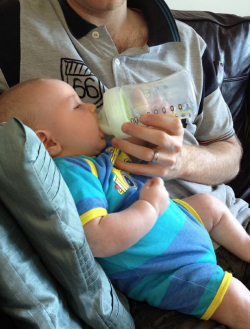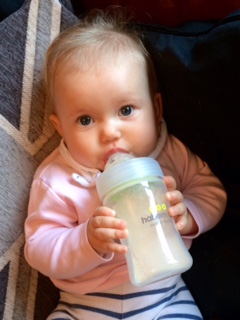Suckle Feeder FAQs
Frequently asked questions about suckle feeding, the Suckle Feeder and why this premium technologically advanced product breaks with tradition and provides added benefits for your baby.
Q: Isn’t the Haberman Suckle Feeder just another bottle?
The Suckle Feeder is different. It is a new technology designed to make babies feed as actively and at the same speed as breastfeeding. It is revolutionary. It is the only feeder that works in this way.
Conventional bottles deliver milk too easily and too fast. Typically, babies must guzzle to keep up with the flow, or be swamped, as can be witnessed by milk over-flowing out of the mouth and running down the chin. As little oral effort is required from the baby, babies feed too quickly, gain weight too fast and often have poor oral development.
- Professor Atul Singhal, of the Childhood Nutrition Research Centre at the Institute of Child Health, University College London reports that between 22-38% of babies now display feeding disorders at weaning.
- Published medical research shows a link between rapid weight gain in the early months of life and obesity, heart disease and diabetes in later life. Read: 'Early Feeding Patterns Shape Future Appetite
 Once conventional bottle-feeding is started, babies frequently reject the breast because bottle-feeding is so much easier. This is not the case with the Suckle Feeder which has been designed to support breastfeeding by:
Once conventional bottle-feeding is started, babies frequently reject the breast because bottle-feeding is so much easier. This is not the case with the Suckle Feeder which has been designed to support breastfeeding by:
- Using the same suckling action and the same oral muscles, requiring the baby works as actively as breastfeeding, so the baby doesn’t get lazy and reject the breast.
- Preventing swamping, guzzling and over-feeding.
- Giving mums more flexibility, so they are encouraged to breastfeed for longer.
Q: Why is the Suckle Feeder different to other anti-colic bottles ?
Before vented ‘anti colic’ bottles were invented, the build up of negative pressure inside the bottle (as more and more milk was extracted) would require the baby to suck harder and harder. Eventually, the teat would collapse and a baby would need to open its mouth to allow air back into the system. The baby would then swallow air with the next mouthful.
Venting the system (‘anti-colic’ bottles) solved these problems but created others:
- Because air enters the system, milk can flow out under gravity. So much less effort is required from the baby.
- Instead of suckling properly, the baby lays back and tries to control the continuous flow, without choking. Medical research shows that when milk flows too easily, oral activity is significantly reduced. Oral activity (suckling) is essential for proper eating skills and speech.
- We are told to ‘eat slowly’ to avoid over eating. This is because it takes the brain time to recognise when stomach is full. Vented bottles feed too quickly, encouraging babies to over-feed. Repeatedly compromising the infant’s ability to recognise when it is satiated does not set good eating habits for the future. Medical research has linked rapid weight gain in the early months of life to significantly increased risks of obesity, heart disease and diabetes in adults.
The Suckle Feeder is different.
When a baby breastfeeds, milk is extracted from the breast by the positive pressure of the jaws and the peristaltic movement and pressure of the tongue.
To use a conventional bottle, a baby must learn a different way to feed. Instead of extracting milk, the positive pressure of the baby’s natural suckling action causes air inside the bottle to compress. The milk simply moves around inside the bottle, rather than being expelled. The baby must apply suction (negative pressure) in order to extract milk or to accelerate the gravity flow.
When a baby feeds from the Suckle Feeder, the teat remains full (i.e. no air to compress) at any angle. The milk in the teat cannot flow back into the bottle. So, when the baby applies natural suckling action, milk is extracted in exactly the same way as in breastfeeding.
The Haberman Suckle Feeder (like the breast) has no back-flow.
It enables the baby to:
- Suckle naturally using full oral activity.
- Work actively to feed
- Feed slowly and avoid guzzling and over-feeding
The Haberman Suckle Feeder compliments and supports breastfeeding and helps to encourage good eating habits because it actually responds like the breast unlike other bottles that have aesthetic features that claim to be ‘breast like’ but still function in the same way as conventional bottles.
Q: Lots of bottles say that they are anti-colic and reduce wind, but babies still get wind and colic. How is the Haberman Suckle Feeder any better and what anti-colic features does it offer?
Babies get colic for many reasons. Babies can get a tummy ache if they ingest air, as trapped wind is painful. Mothers often describe their baby’s wind related pain and associated distress, as colic.
Venting bottles does help to reduce the amount of air that is ingested to some degree, but there are other routes by which air can be ingested. Consequently, babies still suffer from wind and wind-related colic, even if they are using a vented, ‘anti-colic’ bottle.
The Suckle Feeder tackles three causes of wind and colic:
- The teat stays full at any angle, so there is no risk that the baby will swallow a mouthful of air. The baby can, therefore, be positioned more upright to feed (which is better for digestion.)
- It filters out micro bubbles. Pouring milk (even breast-milk) into a bottle causes it to aerate. Big bubbles quickly escape to the surface but tiny, micro bubbles don’t have enough buoyancy to rise under the weight of the milk, in order to reach the surface. These micro bubbles are trapped inside the milk. The Suckle Feeder is the only bottle that filters these bubbles out before the milk enters the teat.
- Babies tend to feed slower with the Suckle Feeder. If babies guzzle they are more prone to swallowing air.
Q: How does the Suckle Feeder differ to original Haberman Feeder used in hospitals?
- The late Tracy Hogg, known as the 'Baby Whisperer', identified the original Haberman Feeder as an ‘essential tool for breastfeeding mothers’ because it is activated by a natural suckling action. The original Haberman Feeder used by hospitals around the world for infants with feeding difficulties was designed over 30 years ago for babies with inadequate feeding ability.
- The new Suckle Feeder is based on the same principle but designed for all babies (those without problems). It has many improvements and additional benefits including:
- Your baby will feed more slowly
- It makes baby work actively
- It tackles three causes of colic.
- The teat stays filled; your baby can feed at any angle
- It is ultra easy to use and clean
 Q: Why do some health professionals say that breastfeeding mums shouldn’t use bottles at all?
Q: Why do some health professionals say that breastfeeding mums shouldn’t use bottles at all?
- If formula is introduced too soon, it can affect the mother’s milk supply. Her supply is stimulated by suckling, so if one feed is missed this results in less suckling.
- Babies are not stupid! If a baby becomes used to a free flow bottle, he can become lazy and may subsequently reject the breast where they have to work more actively.
- Nipple confusion has been cited as a reason why babies reject the breast in favour of bottle. However, it is very unlikely that a baby would reject all the sensory delights of feeding from mum in favour of using an artificial teat. Rejection is more likely the result of bottle-feeding being so much easier.
- Breast milk is better than formula, therefore bottle-feeding is discouraged. However, it should be remembered that most breastfeeding mums want the ability to use a bottle to give expressed breast milk.
Q: Why do I need a Suckle Feeder if I am breastfeeding?
- It provides a means of feeding with expressed breast milk.
- It allows dad, carers, or other family members to share the experience.
- Familiarity and the ability to use the Suckle Feeder is a benefit, just in case mum is taken ill, is away or needs to return to work and combination feed. By giving mums more flexibility, it encourages them to breastfeed for longer.








